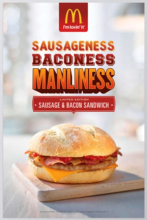Masculinity and Advertising
A 2017 report from the United Kingdom’s Advertising Standards Authority called for a ban on gender stereotypes in advertising because they lead to “unequal gender outcomes in public and private aspects of people’s lives.”[1]
These critics and others suggest that, just as traditional advertising has for decades sexually objectified women and their bodies, today’s marketing campaigns objectify men in the same way. Research and anecdotal reports from doctors suggest that this new focus on fit and muscled male bodies is causing men the same anxiety and personal insecurity that women have felt for decades.[2]
In ads aimed at children, boys are more likely to be portrayed in major roles and as being more adventurous and active than girls. On the rare occasion that male characters are portrayed in a domestic versus an outdoor setting, they commonly appear “hilariously inept” at any household chore they try to do.[3]
Advertising also contributes to the narrow range of roles for men through the aggressive gender-coding of toy packaging This is important because once boys and girls reach school age, they begin to prefer toys they see as being “right” for their gender – though this may be reduced if they see images of non-stereotyped play, such as a girl playing with a toy car.[4]

Masculine stereotyping in ads can even have a direct impact on boys’ health, targeting them with “manly” food that are typically high in fat, heavily processed and short on fibre and vitamins, and bearing loaded names such as the Manwich or Canada’s own Mr. Big chocolate bar. Like other effects of stereotypes, this is caused not just by a desire to seem masculine but to avoid seeming feminine, as men feel that ordering healthful food might make them seem unmanly.[5]
In its most extreme forms, advertising aimed at men directly promotes violence as way of affirming masculinity – as in the ad for the semi-automatic Bushmaster AR-15 rifle whose tagline read “Consider your man card reissued” and which appeared in Maxim, a magazine popular among teen boys.[6]
[1] Depictions, Perceptions and Harm: A Report on Gender Stereotypes in Advertising. (Rep.) (2017) Advertising Standards Authority.
[2] Ganson, K. T., Hallward, L., Cunningham, M. L., Rodgers, R. F., DClinPsych, S. B. M., & Nagata, J. M. (2023). Muscle dysmorphia symptomatology among a national sample of Canadian adolescents and young adults. Body Image, 44, 178-186.
[3] Common Sense Media (2017) Watching Gender: How stereotypes in Movies and on TV Impact Kids’ Development. Retrieved from https://wnywomensfoundation.org/app/uploads/2017/08/16.-Watching-Gender-How-Stereotypes-in-Movies-and-on-TV-Impact-Kids-Development.pdf
[4] Spinner, L., Cameron, L., & Calogero, R. (2018). Peer toy play as a gateway to children’s gender flexibility: The effect of (counter) stereotypic portrayals of peers in children’s magazines. Sex roles, 79(5), 314-328.
[5] Marcoux, H. (2022) ‘Dude Food’ Has Gone Too Far And It’s Hurting Families. Fatherly. https://www.fatherly.com/health/dude-food-masculinity
[6] Plank, L. (2022) How gun makers bait insecure young men into buying weapon. MSNBC. https://www.msnbc.com/opinion/msnbc-opinion/gun-maker-sandy-hook-settlement-exposed-predatory-ads-n1289394
